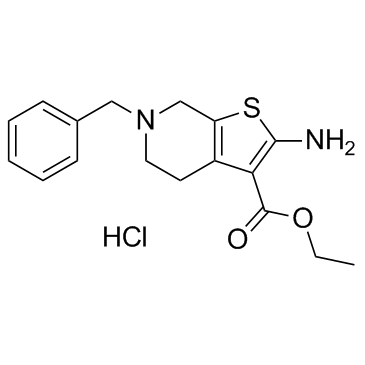Tinoridine hydrochloride (Y-3642 hydrochloride) |
| رقم الكتالوجGC31882 |
Tinoridine hydrochloride (Y-3642 hydrochloride) هو دواء مضاد للالتهاب غير ستيرويدي وله أيضًا نشاط قوي في إزالة الجذور والأكسدة.
Products are for research use only. Not for human use. We do not sell to patients.

Cas No.: 25913-34-2
Sample solution is provided at 25 µL, 10mM.
Tinoridine hydrochloride is a nonsteroidal anti-inflammatory drug and also has potent radical scavenger and antiperoxidative activity.
Tinoridine reduces a stable free radical, diphenyl-p-picrylhydrazyl, in the molar ratio of about 1:2, indicating its free radical scavenging ability. Tinoridine inhibits the lipid peroxidation in rat liver microsomes induced by xanthine-xanthine oxidase system in the presence of ADP and Fe2+, in which hydroxyl radical is formed. Tinoridine is demonstrated to be oxidized in the course of the lipid peroxidation by following the fluorescence derived from the oxidation product of tinoridine. It is also oxidized by the xanthine-xanthine oxidase system in the presence of Fe2+, but its oxidation is slow in the absence of Fe2+ and almost completely inhibited by catalase. Tinoridine is also oxidized by H2O2-Fe2+ system producing OH (Fenton reaction), but it does not affect the reduction of cytochrome c caused by superoxide radical[1].
CCl4 aministration produces a marked decrease in the concentrations of liver microsomal cytochrome P-450 and G6Pase, indicating that hepatic endoplasmic reticulum function is disrupted. Prior treatment of the animals with tinoridine (100 mg/kg) significantly reduces the CCl4-induced alterations in the enzyme activities, and a rapid recovery toward the normal values is observed[2].
[1]. O Shimada, et al. Hydroxyl radical scavenging action of tinoridine. Agents Actions. 1986 Nov;19(3-4):208-14. [2]. Yasuda H, et al. The protective effect of tinoridine against carbon tetrachloride hepatotoxicity. Toxicol Appl Pharmacol. 1980 Mar 15;52(3):407-13.
Average Rating: 5 (Based on Reviews and 35 reference(s) in Google Scholar.)
GLPBIO products are for RESEARCH USE ONLY. Please make sure your review or question is research based.
Required fields are marked with *




















